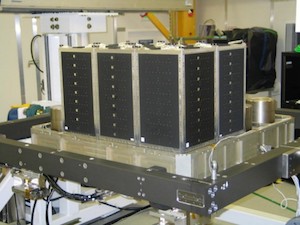Large Area Telescope

Fermi's Large Area Telescope during assembly. This image shows six of the "towers" containing layers to track pairs of electrons and positrons created when incoming gamma rays interact with the instrument's layers of tungsten. (Credit: NASA/DOE/Fermi LAT Collaboration)
The primary instrument on Fermi is the Large Area Telescope, or LAT, was built at Stanford University. It can see about a fifth of the sky at a time, giving it what astronomers call "a wide field-of-view." The LAT detects gamma rays with energies ranging from 20 MeV to 300 GeV (10 million to 150 billion times the energy of the light detected by the human eye). With the resolution and sensitivity of its imaging capabilities, the LAT represents a major advancement over previous gamma-ray telescopes.
The LAT detects gamma rays by using a technique known as pair-conversion. When a gamma ray slams into a layer of tungsten in the detector, it creates an electron and positron pair. These particles in turn hit another, deeper layer of tungsten, each creating further particles and so on. The direction of the incoming gamma ray is determined by tracking the direction of these cascading particles back to their source using high-precision silicon detectors. Furthermore, a separate detector counts up the total energy of all the particles created. Since the total energy of the particles created depends on the energy of the original gamma ray, counting up the total energy determines the energy of that gamma ray. In this way, Fermi is able to make gamma-ray images of astronomical objects, while also determining the energy for each detected gamma ray.



